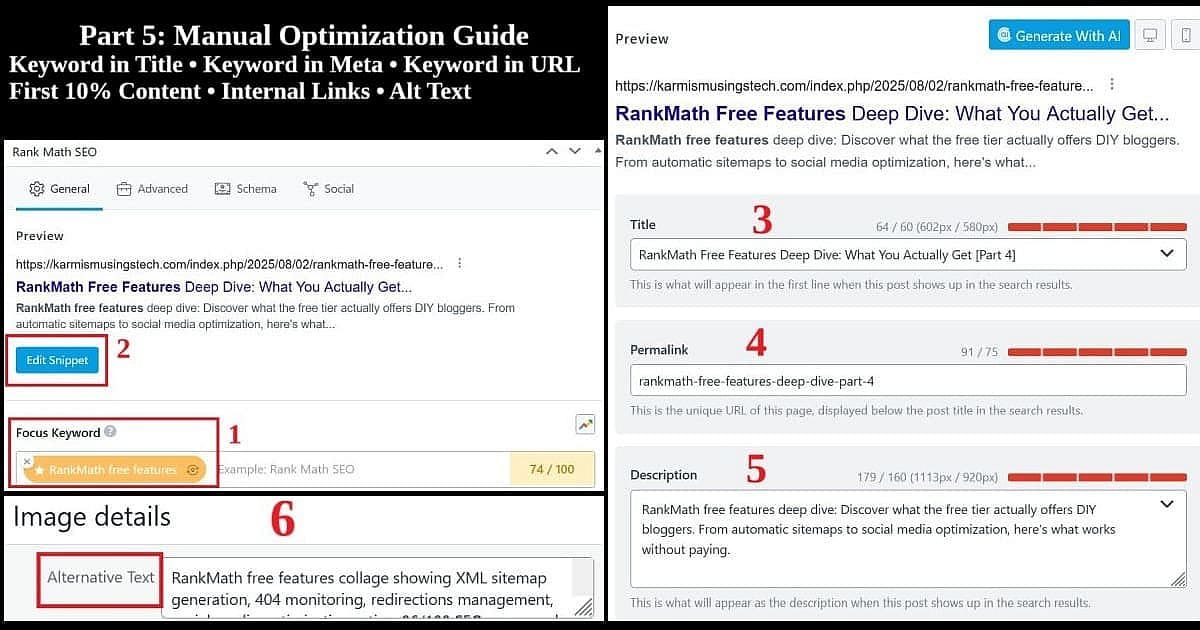
Manual SEO optimization doesn’t require costly tools or subscriptions. Often, the best solutions come from systematic troubleshooting and leveraging free tools like RankMath—exactly what happened while preparing this very post.
Yesterday, I encountered a “couldn’t fetch” error in Google Search Console that was blocking my sitemap submissions. A quick check with an AI assistant suggested I needed a robots.txt file, but the diagnosis felt incomplete. Instead of turning to additional paid tools, I used Claude to dive deeper into the issue.
The result? I discovered that RankMath’s free version wasn’t generating a virtual robots.txt file because Advanced Mode wasn’t enabled. By enabling it, I fixed both the robots.txt creation and the sitemap URL configuration. This hands-on approach showcased the power of RankMath’s free features and manual SEO optimization—solving the problem efficiently without extra costs.
This experience perfectly illustrates today’s tutorial: how to achieve professional SEO results using manual techniques and free tools like RankMath to get the job done effectively.
Series Progress: From SEO Confusion to Success
Before diving into manual optimization techniques, let’s recap our journey:
• Part 1: 71/100 SEO score – Moving from SEO confusion to success • Part 2: 73/100 SEO score – RankMath setup and configuration
• Part 3: 77/100 SEO score – “Fix Something, Break Something” reality check • Part 4: 74/100 SEO score – Free features deep dive and sitemap resolution • Site-wide improvement: 86/100 overall blog score after RankMath implementation
Part 5 Goal: Show DIY bloggers how to manually optimize content like professionals using AI assistance instead of purchasing expensive SEO analysis software.
The Manual Optimization Approach
Core concept: Use Claude as your AI assistant combined with RankMath’s excellent free analysis tools to achieve professional SEO results through strategic manual techniques.
Target audience: Novice bloggers who want professional SEO results using smart optimization methods.
Value proposition: Leverage manual SEO optimization techniques with existing AI tools to deliver measurable improvements without additional software purchases.
Step 1: Focus Keyword Research Using Free Methods
Using Claude for Keyword Strategy
Rather than relying solely on automated tools, start your manual SEO optimization process by consulting Claude about your topic focus.
Prompt example: “I’m writing about manual SEO techniques for DIY bloggers. What focus keyword should I target, and what related terms should I include?”
Free Keyword Research Tools
Combine Claude’s strategic guidance with these free resources:
• Google Keyword Planner – Search volume and competition data • Answer the Public – Question-based keyword variations
• Google Autocomplete – Real user search patterns • Related searches at the bottom of Google results pages
Evaluating Keyword Difficulty
Claude can help you assess whether a keyword is realistic for your site’s authority level. Share your domain stats and ask for honest feedback about keyword competitiveness—something that saves expensive keyword analysis fees from premium SEO tools.
Step 2: SEO Title Crafting That Converts
Writing Compelling, Keyword-Rich Titles
Your SEO title needs to accomplish multiple goals: include your focus keyword, stay under reasonable character limits (though my 89-character title in a recent post scored 74/100), and drive click-through appeal.
Manual SEO optimization for titles involves:
• Lead with your focus keyword when it sounds natural • Include emotional triggers like “Novice Steps to Pro Results” • Add series indicators for content organization [Part 5] • Test variations with Claude for different angles
Using Claude for Title Variations
Instead of paying for premium AI title generation tools, ask Claude to generate 5-10 variations of your title concept. Compare options for keyword placement, emotional appeal, and search intent matching.
Step 3: Permalink Optimization Strategy
Creating Clean, Readable URLs
Your permalink should include your focus keyword while remaining concise and readable. For this post: manual-seo-optimization-novice-steps-pro-results-part-5
Best practices for manual SEO optimization of permalinks:
• Include primary focus keyword naturally • Remove stop words when possible (but keep readability) • Use hyphens to separate words • Keep URLs under 75 characters when practical • Avoid special characters and numbers unless necessary
Custom Permalink Structure Considerations
If your site uses custom permalink structures (like my /index.php/ setup due to server requirements), ensure consistency across all posts while maintaining keyword inclusion.
Step 4: Meta Description Writing That Drives Clicks
Compelling 150-160 Character Descriptions
Your meta description should include your focus keyword while compelling users to click through from search results.
Manual SEO optimization for meta descriptions involves:
• Include focus keyword naturally in the first sentence • Add a clear value proposition – what will readers learn? • Include call-to-action elements that encourage clicks • Stay within 150-160 characters for full display
Testing Meta Descriptions with Claude
Ask Claude to review your meta description for keyword inclusion, compelling language, and search intent matching. This saves expensive AI analysis fees while ensuring quality.
Step 5: Content Integration Points
Strategic Keyword Placement
Manual SEO optimization requires thoughtful keyword integration throughout your content:
Beginning (First 10%): Include your focus keyword in the opening paragraph naturally—like “Manual SEO optimization doesn’t require expensive AI subscriptions” that opens this post.
Middle Sections: Weave the focus keyword into subheadings and body content where it enhances readability rather than disrupting flow.
Conclusion: Reinforce the focus keyword in your closing thoughts, connecting back to the main theme.
Avoiding Keyword Stuffing
The goal isn’t maximum keyword density—it’s natural integration that serves readers while signaling topic relevance to search engines. Claude can help you identify when keyword usage feels forced versus natural.
Step 6: Using RankMath’s Free Analysis Tools
Interpreting the Scoring System
RankMath’s free analysis provides valuable feedback without additional costs:
• Green indicators show successful optimization • Orange warnings suggest improvements
• Red errors require immediate attention
Focus on addressing red errors first, then work through orange improvements systematically.
Acting on Specific Recommendations
Instead of paying for premium AI analysis, use RankMath’s free suggestions combined with Claude’s strategic guidance to prioritize improvements that deliver the biggest SEO impact.
Advanced Manual Techniques
Internal Linking Strategy
Connect your content to previous posts in your series naturally. This post links to previous parts of this series while building topic authority through related content connections.
External Authority Links
Link to authoritative sources like Google Search Console, RankMath documentation, and other trusted SEO resources to enhance content credibility.
Image Optimization
Ensure your main image includes descriptive alt text with focus keyword integration when natural: “RankMath interface showing manual SEO optimization steps for DIY bloggers.”
Real-World Results: Measuring Success
This manual SEO optimization approach delivers measurable results:
• Time investment: 2-3 hours for thorough optimization • Cost savings: No premium AI fees for basic optimization tasks
• Quality results: Competitive SEO scores using free tools • Skill development: Learning transferable optimization techniques
Compare this to premium AI-powered SEO tools that require expensive subscriptions—costs that add up quickly for content creators publishing regularly.
Troubleshooting Common Issues
When Manual Optimization Feels Overwhelming
Break the process into manageable steps. Focus on one element at a time: keyword research, then title crafting, then meta descriptions. Manual SEO optimization works best as a systematic process rather than trying to perfect everything simultaneously.
Using Claude as Your SEO Consultant
Claude excels at strategic guidance, content review, and identifying optimization opportunities. Ask specific questions like “Does this title effectively include my focus keyword?” or “How can I improve this meta description’s click-through appeal?”
Series Wrap-Up: The DIY SEO Journey
From a starting score of 71/100 in Part 1 to today’s advanced manual SEO optimization techniques, this series proves that DIY bloggers can achieve professional results without expensive subscriptions.
Key takeaway: You don’t need expensive AI subscriptions to do professional SEO. You need the right process, free tools, and strategic AI assistance to guide your optimization decisions.
Coming up in Part 6: We’ll tackle 404 monitoring and redirection management—another technical SEO area where manual methods outperform expensive automated solutions
